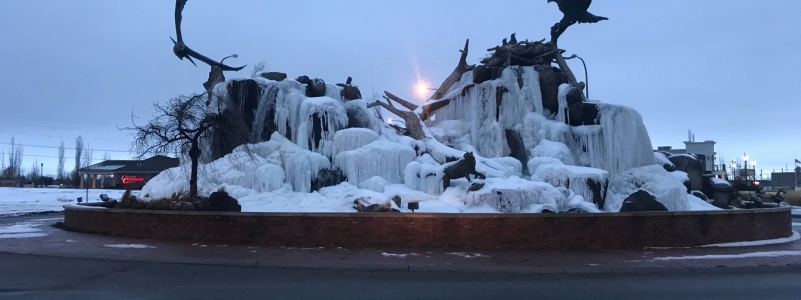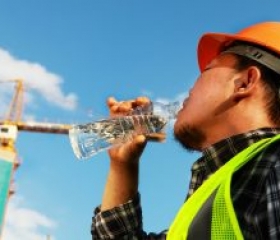Working in Cold Weather
Cold weather safety is a topic that should be discussed at length among utility workers who perform any outdoor job functions. That’s because, as with heat stress, cold stress can be a fatal threat. When you’re exposed to freezing temperatures for long periods of time, you run the risk of losing a dangerous amount of body heat, which, if not corrected immediately, could lead to frostbite, hypothermia and even death. There are a number of things to think about prior to and when working in the cold. We’ll cover three of the most important things about working in the cold weather: dressing properly, staying hydrated and eating right, and keeping an eye on your co-workers.
Keep These 3 Things in Mind When Working in Cold Weather
1. Dress Properly
The golden rule for winter weather preparation is to dress in layers. One of the biggest problems with working in the cold is getting too warm and sweaty. If it’s a cold and windy day, hypothermia can begin within just a few minutes. So, layering is key. Here are some layering basics:
- Layer 1 (base layer): Wear a light, long-sleeved base layer close to your skin. Thinner layers wick sweat better and dry faster.
- Layer 2 (mid-layer): This layer also should be a thin layer. Wool is a good choice; not only is it warm, but it will retain most of its warmth when wet. There are some fantastic flame-resistant wool garments currently on the market.
- Layer 3 (heat trap): This should be a zippered jacket with a hood – hooded zip-up sweatshirts are most commonly used for this layer.
- Layer 4 (outer shell): Choose a waterproof but breathable fabric, and make sure the garment is large enough to fit over all of the other layers.
Now that your core is protected from the cold, let’s talk about your extremities. When you get cold, your body reduces blood flow to the skin’s surface to keep your internal organs warm. In the process, though, your fingers, toes, earlobes and the tip of your nose pay the price, experiencing decreased blood flow. Usually when parts of your body get cold, they turn red and begin to hurt. When frostbite begins to occur, however, symptoms include a lack of color and a loss of feeling.
A hard-hat liner will protect your ears from the cold, while a balaclava will protect both your ears and your nose. For your hands, glove liners are a good place to start for finger protection. Your feet can best be protected by either one thick pair or two thin layers of socks, preferably a high-quality wool sock.
A couple of final clothing notes: Good moisture-wicking fabrics include polyester, polypropylene and merino wool. But remember to make sure the clothing you and your crew wear during working hours fully meets the requirements – including the minimum flame-resistant properties – set by your company and needed to safely execute the job at hand.
2. Stay Hydrated and Eat Right
It’s important to stay hydrated whether you’re on or off the job, but it’s especially important when you’re working outdoors in cold weather. While it is true that you can be well hydrated and become hypothermic, a person who is dehydrated will become chilled more quickly and thoroughly and recover more slowly.
Eating right during cold weather work includes increasing your caloric intake. Your body is burning more calories to heat your blood to keep you warm. If you don’t replace those calories, you won’t be able to perform at peak efficiency.
3. Keep an Eye on Your Co-workers
The symptoms of hypothermia and frostbite may not always be noticeable to those suffering from the conditions, so it’s important to know the signs and symptoms to look for to keep your co-workers safe.
Signs of hypothermia include the “umbles” – stumbles, mumbles, fumbles and grumbles – which signify changes in motor coordination and levels of consciousness. Other symptoms are uncontrollable shivering; severe shaking; drowsiness; exhaustion; slurred speech; memory lapses; irrational behavior; and dilated pupils.
Signs and symptoms of frostbite include paleness of the skin; sensation of coldness or pain; pain that disappears after a while as body tissue freezes; and body tissue that becomes increasingly whiter and harder.
If you notice any of the above signs or symptoms, take the proper steps to treat them. These include the following:
- Remove sweaty, wet clothing and replace it with dry layers. If needed, don additional layers to compensate for lower temperatures.
- Get inside and out of cold conditions.
- Increase hydration and caloric intake to help refuel the body and allow it to better regulate heat.
- Depending on the severity of the situation, heat packs or hot water bottles may need to be introduced at the neck, armpits and groin area.
- It is important to note that because of the circulatory and respiratory issues hypothermia and frostbite can cause, professional medical attention is a must in severe cases. All workers should be trained to recognize when this type of attention is needed.
Anyone who spends much time outside in cold weather may find themselves at risk of frostbite and hypothermia. Different individuals will have different tolerances to cold, so one size does not fit all when watching for signs and symptoms. Be knowledgeable, be alert and be safe.
This article was shared from the Incident Prevention website.







